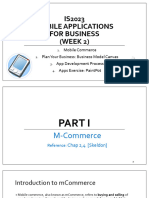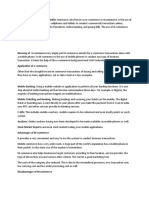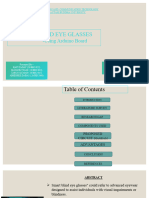0% found this document useful (0 votes)
38 views14 pagesMobile (M) Commerce
This document discusses mobile commerce (m-commerce), which involves buying and selling goods and services through mobile devices like smartphones and tablets. M-commerce is categorized into mobile shopping, mobile banking, and mobile payments. It provides advantages like a large customer base, convenience, and product variety. Challenges include poor mobile interfaces, payment issues, and tax compliance complexity. Future trends driving m-commerce growth include mobile retargeting, augmented reality, mobile search engine optimization, mobile banking, and artificial intelligence assistants.
Uploaded by
openhousehereCopyright
© © All Rights Reserved
We take content rights seriously. If you suspect this is your content, claim it here.
Available Formats
Download as PPTX, PDF, TXT or read online on Scribd
0% found this document useful (0 votes)
38 views14 pagesMobile (M) Commerce
This document discusses mobile commerce (m-commerce), which involves buying and selling goods and services through mobile devices like smartphones and tablets. M-commerce is categorized into mobile shopping, mobile banking, and mobile payments. It provides advantages like a large customer base, convenience, and product variety. Challenges include poor mobile interfaces, payment issues, and tax compliance complexity. Future trends driving m-commerce growth include mobile retargeting, augmented reality, mobile search engine optimization, mobile banking, and artificial intelligence assistants.
Uploaded by
openhousehereCopyright
© © All Rights Reserved
We take content rights seriously. If you suspect this is your content, claim it here.
Available Formats
Download as PPTX, PDF, TXT or read online on Scribd
/ 14

































































